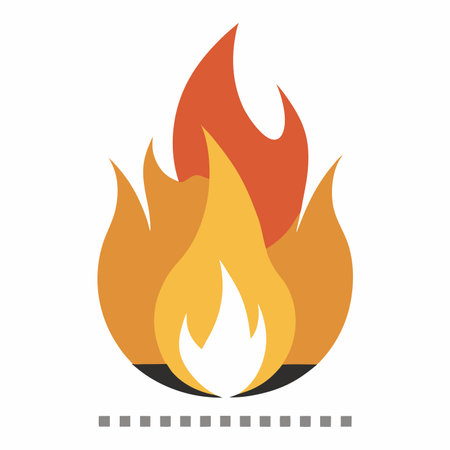Understanding Fire Risks in UK Homes
When it comes to fire safety for babies, understanding the specific risks present in British households is an essential first step. Typical UK home layouts—whether you’re living in a Victorian terrace, a semi-detached property, or a modern flat—can all present unique fire hazards. Common culprits include kitchen appliances like electric kettles, toasters, and cookers, which are often left plugged in and can easily overheat if not maintained properly. Portable heaters and tumble dryers, especially those located in confined spaces such as airing cupboards or under-stairs storage, are also frequent sources of accidental fires.
Additionally, open fireplaces and wood-burning stoves, popular features in many British homes, pose significant risks if not properly guarded or maintained. Extension leads and overloaded plug sockets are another concern, particularly in older homes where original wiring may not be up to modern standards. Candles and smoking materials remain common hazards too, often overlooked during busy family routines. Recognising these risks within the context of your home’s layout is key to creating a safer environment for your baby, prompting proactive steps to prevent accidents before they occur.
Essential Fire Safety Equipment for Babies
When it comes to safeguarding your little one, having the right fire safety equipment in your UK home is crucial. The British climate and housing styles – from Victorian terraces to modern flats – require specific solutions. Below, we’ll guide you through the must-have fire safety gear every parent should consider to protect their baby.
Must-Have Fire Safety Gear
| Equipment | Why It’s Essential | UK Standards/Recommendations |
|---|---|---|
| Smoke Alarms | The first line of defence; alerts you instantly if smoke is detected, giving you vital time to react, especially important with babies who can’t self-evacuate. | Conform to BS EN 14604 (for smoke alarms); install at least one on every level of your home as per UK guidance. |
| Fire Blankets | Perfect for quickly tackling small kitchen fires or wrapping around yourself and your baby if escape routes are compromised. | Look for BS EN 1869 certification; keep within easy reach in the kitchen but out of children’s reach. |
| Carbon Monoxide Detectors | Especially important in homes with gas appliances; protects against this invisible, odourless threat that’s dangerous for babies. | Should meet BS EN 50291 standards; place near boilers or any solid fuel appliance. |
| Baby-Friendly Escape Tools | Specialised window break tools or ladders designed for use with babies, enabling safe exit from upper floors in an emergency. | Select products with clear instructions and British safety certification; practice using them during family fire drills. |
Tips for Choosing Baby-Safe Products
- Test Regularly: Check alarms and detectors monthly and replace batteries as needed.
- No Loose Cords: Choose alarms and gadgets without dangling cords or small detachable parts to prevent choking hazards.
- Consider Smart Tech: Smart smoke alarms that link to your phone can provide extra peace of mind when away from home.
- User-Friendly Design: Opt for devices that are easy to install and operate, even in stressful situations.
British Standards Matter
Always look for the official British Standard kitemark on any fire safety product. This ensures it meets strict UK regulations, offering a higher level of reliability and safety for your family. By investing in certified equipment and keeping it well-maintained, you’re taking a big step towards a safer home environment for your baby.

3. Fireproofing the Nursery and Living Areas
Ensuring your babys safety begins with how you arrange and furnish the rooms where they spend most of their time. In the UK, adhering to stringent fire safety standards is not just recommended—its essential for peace of mind. Here are some practical tips to help you create a safe environment in your nursery and living areas.
Choose Flame-Resistant Furnishings
Opt for cots, mattresses, curtains, and upholstered furniture that comply with British fire safety regulations, such as the Furniture and Furnishings (Fire) (Safety) Regulations 1988. Look for labels stating items are fire-retardant or meet BS 5852 standards. This simple check can significantly reduce fire risks.
Arrange Furniture Wisely
Keep all cots, beds, and soft furnishings well away from heaters, radiators, plug sockets, and electrical appliances. Ensure no trailing wires or overloaded extension leads are within reach of curious little hands. Avoid placing furniture near windows with blinds or curtains that could potentially catch fire from a faulty heater.
Clear Clutter and Minimise Soft Toys
While it’s tempting to fill your babys room with soft toys, blankets, and cushions, too many can increase the risk of fire spreading quickly. Stick to essentials and store extras safely out of reach. Regularly declutter to keep escape routes clear and minimise potential fuel for a fire.
Install Smoke Alarms and Test Regularly
Fitting a smoke alarm in every room where your baby spends time is a crucial step—this includes nurseries and living areas. Choose models compliant with BS EN 14604 standards. Test them weekly and change batteries twice a year to ensure theyre always working when you need them most.
Avoid Open Flames and Hot Appliances
Avoid using candles, oil burners, or open fires in rooms where babies are present. If you have a fireplace, make sure it’s fitted with a certified fireguard that meets British Standards (BS 8423). Always supervise when heaters or irons are in use, and unplug appliances when not needed.
Prioritise Safe Storage Solutions
Store matches, lighters, cleaning products, and other hazardous items in locked cupboards out of sight and reach. Choose storage units made from materials that comply with UK fire resistance guidelines for added security.
By following these tips rooted in UK safety standards, you’ll be well on your way to creating a nursery and living space that is both welcoming and as safe as possible for your baby—giving you extra reassurance as your little one grows and explores their world.
4. Creating a Family Fire Escape Plan
One of the most crucial aspects of fire safety for babies in the UK is having a clear and well-practised family fire escape plan. Properties across the UK, especially flats and terraced houses, present unique challenges due to their layouts and shared access points. Here’s a step-by-step guide to creating an effective evacuation plan that suits your home.
Step-by-Step Guide to Drafting Your Escape Plan
- Identify All Possible Exits: Walk through your home and locate all exits, including front doors, back doors, windows (especially on the ground floor), and communal corridors if you live in a flat.
- Choose Two Escape Routes: For every room, especially where your baby sleeps, identify two ways out. This could include a window as an alternative if the primary door is blocked.
- Assign Roles: Decide who will be responsible for getting the baby out safely. Make sure everyone in the household knows their role during an emergency.
- Keep Pathways Clear: Ensure hallways, stairs, and exits are free from obstructions at all times. Avoid storing prams or shoes near doors.
- Practice Regularly: Carry out fire drills with your family at least twice a year. Practice both daytime and night-time scenarios so everyone feels confident.
Tailoring Your Plan: Flat vs Terraced House
| Property Type | Main Escape Route | Alternative Route | Special Considerations |
|---|---|---|---|
| Flat | Main entrance via communal corridor or stairwell | Bedsheet ladder from window (if safe), balcony access | Avoid lifts; know location of fire alarms and extinguishers; check communal doors are unlocked |
| Terraced House | Front or back door directly to street/garden | Ground floor window exit | Narrow stairs; keep keys near door but out of sight from outside; inform neighbours if needed |
Pointers for Families with Babies
- Place a sticker on the babys bedroom window to alert firefighters in case of emergency (optional but recommended).
- If living in a flat above ground level, consider investing in a compact escape ladder designed for UK window sizes.
Top Tip:
The London Fire Brigade recommends keeping mobile phones charged overnight in case you need to call 999 quickly. Always keep house keys within reach but out of sight from windows and letterboxes.
5. Teaching Fire Awareness to Young Children
Introducing fire safety concepts to young children may sound daunting, but it’s essential for building their awareness and confidence. In the UK, teaching fire awareness to little ones should always be done in a calm, age-appropriate manner that reassures rather than frightens them. Here are some practical suggestions and useful UK-specific resources to help parents and carers get started.
Keep It Simple and Positive
For babies and toddlers, focus on simple messages such as “hot things can hurt” or “never touch matches or lighters.” Use positive reinforcement—praise your child when they follow safe behaviours around heaters, candles, or the cooker. Avoid graphic details or frightening scenarios; instead, keep explanations gentle and reassuring.
Storytelling and Play
Children learn best through stories and play. The UK’s Fire Kills campaign offers colourful storybooks like “Frances the Firefly” that gently introduce fire safety themes. Role-playing games with toy fire engines, firefighters, and dolls can help children understand what to do if they ever hear a smoke alarm. Sing simple songs about calling 999 in an emergency and practise “get out, stay out” together as a game.
Make Use of Local Resources
Many local UK fire services run free family-friendly open days and online sessions where children can meet firefighters, see real equipment, and hear fire safety tips in person. Check your local fire brigade’s website for events or downloadable activity sheets designed especially for young children. The London Fire Brigade’s Kids Zone is an excellent online resource packed with interactive games and videos tailored for little learners.
Repetition Builds Confidence
Revisit fire safety lessons regularly so they become second nature as your child grows. Practise your family escape plan every few months—make it fun by timing how quickly everyone can safely reach your meeting point outside. Remember to keep all conversations calm and supportive; your aim is to empower your child with knowledge, not cause anxiety.
Where to Find More Help
If you’re unsure where to begin, organisations like the Royal Society for the Prevention of Accidents (RoSPA) offer guidance specifically for parents of babies and toddlers. Your local health visitor or children’s centre may also have information on home safety courses or advice lines you can use for further support.
By using these reassuring strategies and trusted UK resources, you’ll help your little one develop lifelong respect for fire safety—setting them up for a safer future at home.
6. Shopping Tips: Choosing Reliable Fire Safety Products
When it comes to protecting your baby from fire hazards, investing in certified fire safety products is non-negotiable. In the UK, not all fire safety equipment is created equal, so knowing what to look for and where to shop is crucial for parents. Always prioritise products that carry the Kitemark (BSI), a symbol of quality and rigorous British Standards testing. For smoke alarms and carbon monoxide detectors, ensure they meet the BS EN 14604 and BS EN 50291 standards respectively. Another mark to watch for is the CE marking, which indicates compliance with EU safety requirements.
Reliable places to purchase certified fire safety products include major UK retailers such as Argos, John Lewis, and B&Q. Specialist stores like Screwfix or Toolstation also offer a range of trusted brands. If you prefer online shopping, websites like Amazon.co.uk and the official British Red Cross shop stock reputable options—just make sure to check product descriptions for relevant certifications.
For peace of mind, avoid buying second-hand or unbranded fire safety devices, as these may lack up-to-date certification or could be compromised in performance. When choosing items such as fire blankets, extinguishers, or escape ladders, look for clear labelling with manufacturing dates and expiry information.
Lastly, don’t hesitate to consult your local Fire & Rescue Service for advice—they often provide free home safety visits and can recommend trustworthy suppliers in your area. By purchasing certified products from reputable UK retailers and recognising essential British safety marks, you’re taking an important step towards creating a safer environment for your baby.


